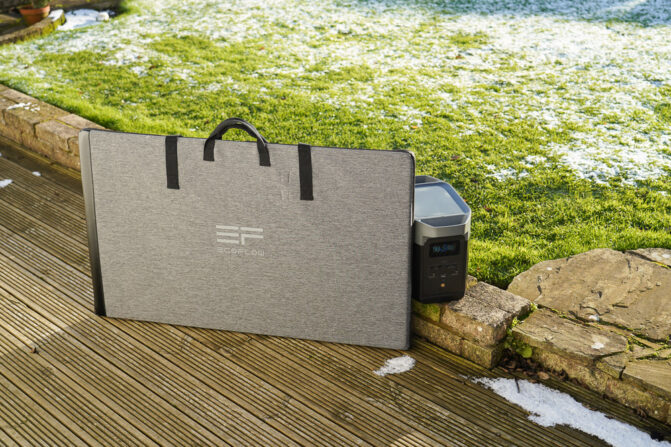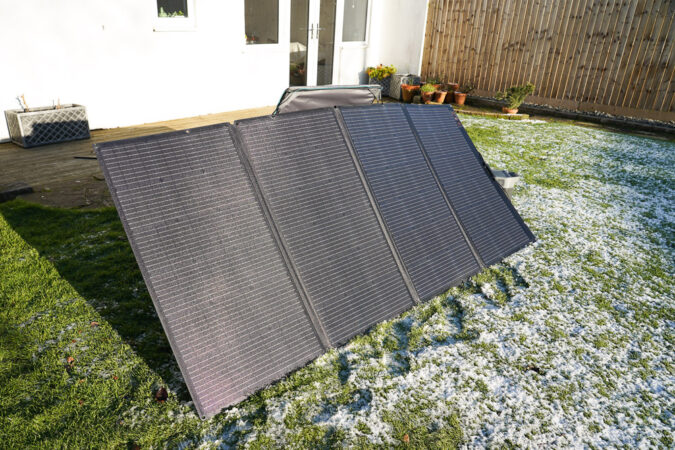So, picture this… You’re out camping and caravanning for a week (or two, or more). And, you need a steady supply of electricity, far away from the nearest mains outlet. If you’re that off-the-grid, you’ll most likely have a power station at the ready. However, there’s still a concern that you’d eventually run out of power at some point. In that case, how do to mitigate and prevent it from happening?
One solution is to have it hooked up to a portable solar panel. Although, given that solar tech is still in its infancy, there are some drawbacks. Mainly, most portable solar panels are probably not going to be enough to keep your electrical accessories charged. Especially, if you’re drawing a lot of power. If you do require more, perhaps EcoFlow’s big-boy 400W portable solar panel might do it for you.
We’ve previously looked at its smaller siblings, EcoFlow’s similar-in-design 110W and 220W panels. But that begs the question, does spending £999 on the giant 400W panel make its wattage worth it? Well, if portability is on your mind, just know that the 400W unit is large compared to the other two. The 110W and 220W kit, in contrast, can easily be lugged around.
Despite the latter’s sheer volume and mass, it’s somewhat portable. And, you can handily stick them into any campervan for a weekend getaway. However, unlike those two, which were already getting bulkier as you’re rising in wattage, the 400W panel here is an absolute beast. It weighs 16kg (or up to 19kg when you’re accounting for its case/stand).
Size Really Does Make A Difference
Nevertheless, this is borderline on the limit of “portable”, I think. It’s just under my physical limit for how much I’d want to carry around with me. I’d also argue that unlike the 110W and 220W ones, it doesn’t strike me that this 400W solar panel is something you’d bring out for a casual camping trip. Well then, where else would you want a high-output solar panel that’s this large and heavy?
This is perfect, for example, if you have a remote and detached building. Or, if you want to mount it atop a caravan or camper for the semi-long term. After all, in my experience, it can take two people to comfortably unfold the panels and set it all up. Its lack of mobility is for a good reason though, as once you unfold and expand it, it has a massive surface area to capture more of the sun.
With greater exposure to sunlight, it’ll of course afford you a much higher output rate – 400 watts, in this instance. Overall, it’s still better than purely static, in-place solar panels. With a portable unit like this, you can physically move and rotate it around and re-position it to better aim at the sun, when it starts cycling throughout the day. Such versatility is welcomed, seeing how sensitive solar can be.
EcoFlow themselves claim a solar efficiency rating of around 23%, which is among the best that you could find on the market today. At a whopping 400W, this solar panel is designed more to suit some of EcoFlow’s larger power stations, like the DELTA mini. Though, it could naturally be used to charge their smaller power stations too without any problems, such as the RIVER or newer RIVER 2.
Charges Up Like A Breeze
In our tests, we paired EcoFlow’s 400W portable solar panel with one of the biggest power stations that you can buy, the DELTA 2. It has a 1kWh (specifically, around 1,024kWh) battery capacity, and could be topped up using the 400W panels, under ideal conditions (i.e. with strong, direct sunlight), in about 3 hours. This alone is outstanding, given that we’re relying on solar charging alone.
Still, do give those figures a grain of salt. In the real world, you should ideally expect it to be longer, maybe in the 4-hour mark or so. This is a similar caveat that we’ve noticed while reviewing its tinier siblings, the 110W and 220W panels. In other words, you’re never going to notice that full 400W of charge, as there are inefficiencies and the sunlight to account for – which is, to be fair, expected.
If the sun isn’t shining as brightly, or if there are overcast clouds or trees blocking your view, the solar panel isn’t going to receive nearly enough sunlight to output a steady 400W. To best maximise the charging, the included carrying case also doubles as a portable kickstand once you unfold it. It can then position the solar panels between 40° to 80°, depending on how you adjust them.
And while you’re setting it all up, it’s a good idea to be wary of how you position it. That kickstand, though fairly sturdy for what it is, can still flex and bend underneath the massive weight of all those solar cells. If you’re crafty enough, you may instead fashion some sort of mount or brace for it, where you could install it more steadily, such as on the roof of your caravan.
Versatility To The Max
If you somehow find that 400W is still insufficient, then EcoFlow has its solutions. You can get three of these and string them together to output an impressive 1,200W for your power station. Plus, any EcoFlow power station comes with built-in algorithms to ensure a constant and steady power supply, without stressing it out or drawing too much power at a time from the attached solar panels.
Even better still, you don’t have to worry about babying that 400W solar panel, either. EcoFlow uses a combination of EVA as well as fibreglass to make sure that they’re both flexible and rigid. It allows them to tolerate stresses much more readily. Additionally, it comes with an IP68 rating for waterproofing and dust-proofing to protect the solar cells, thanks to its reinforced ETFE protective coating up top.
In summary, EcoFlow’s 400W portable solar panel is among the best of the best in the business. It’s not for everyone, most definitely. If you’re a casual camper and don’t spend too long away from the local grid, you really don’t need anything larger than their 110W and 220W offerings. Meanwhile, a 400W solar panel is mainly catered to the more hardcore, adventurous, outdoorsy types.
For those who go on long expeditions into the wilderness or spend their lives travelling from one side of the country to the other in an RV or camper… Or, anyone living the peak of the #vanlife, then this is the right bit of kit for them. Whether you’re using a power station as a backup electrical supply and want to keep going for days without worry, a huge solar panel like this is worth looking into.












